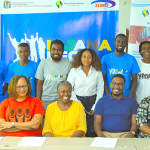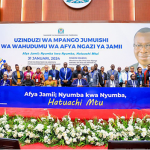Pregnancy and childbirth complications remain the leading causes of death and disability among women of reproductive age in Tanzania. According to the 2015/16 Tanzania Demographic Health Survey and Malaria Indicator Survey (TDHS-MIS), the maternal mortality ratio (MMR) in Tanzania was 556 deaths per 100,000 live births while the neonatal mortality ratio (NMR) was between 24 (in rural areas) to 44 deaths (in urban areas) per 1000 live births.
Despite national strategies and programs to reduce maternal and neonatal deaths that have been implemented in Tanzania, a comprehensive national documentation of these interventions and their impacts has not been conducted. To address this gap, the Jakaya Mrisho Kikwete Foundation (JMKF) in collaboration with the Ministry of Health (MoH), President’s Office Regional Administration and Local Government (PO-RALG) and the National Institute of Medical Research (NIMR) Mwanza conducted a comprehensive national mapping of current and past interventions addressing maternal and newborn deaths in Tanzania Mainland for the period 2016-2021.
This mapping aimed to establish a national baseline report on the Maternal and Newborn Health (MNH) landscape in Tanzania Mainland, identifying practices/interventions, gaps and opportunities in MNH that will guide planning at all levels.
The mapping was conducted in 184 councils across the 26 regions of Tanzania Mainland for the period January 2016 to June 2021. Data was collected using an online self- administered questionnaire with both open and closed-ended questions, completed by the Reproductive and Child Health Coordinators both at Regional and District levels (R/DRCHCos) and the representatives from MNCH Implementing Partners (IPs). Data were uploaded as received to NIMR Mwanza’s file transfer protocol server using the Census and Survey Processing System (CSPro). Descriptive statistics and proportions were analyzed using Stata version15. Qualitative data were analyzed following a deductive approach.
A total of 8,341 health facilities (Hospitals, Health Centers, and Dispensaries) with different levels of ownership were reported. Majority (72.9%) of the health facilities reported were owned by the Government. A total of 11 (6.0%) councils reported having no hospitals but have health centers and dispensaries. Reproductive and Child Health (RCH) services were reported in 86.3% of all health facilities. Availability of Basic Emergency Obsteteric Newborn Care (BEmONC) services was reported at 53.7% and 69.5% of all dispensaries and health centers respectively. About 63.0% of all councils reported having at least one Community Health Workers (CHW) in each village/street.
For the period under review, 8,789,714 deliveries were documented, of which 87,136 (1.0%) were stillbirths. Most (39.1%) of the reported deliveries occurred in dispensaries (39.1%) and health centers (24.9%). Eight thousand, three hundred twenty (8,320) maternal deaths and 44,393 neonatal deaths were reported over the past five years (2016-2021). Obstetric haemorrhage was reported as a leading cause of maternal deaths (43.2%) while birth asphyxia was reported as a leading cause of neonatal deaths (40.6%).
MNH interventions were categorized as either those implemented directly by the councils or by MNCH IPs. Between 2016-2021, 182 (98.9%) of all councils reported having received health basket funds to implement different MNH interventions and 119 (64.7%) councils reported that they had allocated funds generated from their local sources to implement MNH interventions. In addition, over the same period 44 IPs reported having MNCH interventions implemented in different councils in Tanzania Mainland. The majority of the MNH interventions implemented, by both councils and IPs, targeted issues related to delays in receiving adequate care at health facilities (delay 3, of the three-delay model).
It is recommended that this mapping exercise be continuous and a tool/logbook to document ongoing MNH programs be developed for Local Government Authorities (LGA). Specifically, this mapping recommends: scaling up of effective MNH interventions, improving MNH intervention coverage, enhancing coverage of CHWs, and improving the availability of health data and information at all administrative levels. This mapping aimed to establish a national baseline report on the Maternal and Newborn Health (MNH) landscape in Tanzania Mainland, identifying practices/interventions, gaps and opportunities in MNH that will guide planning at all levels.



